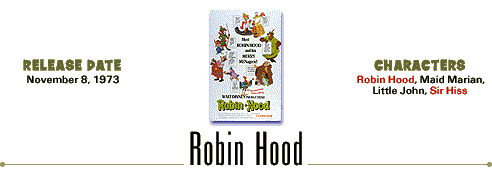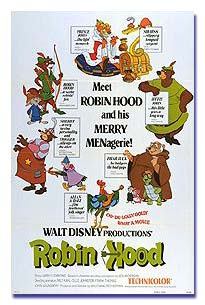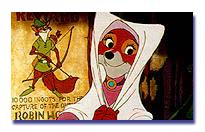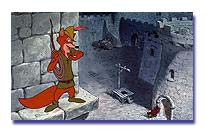 |
 |
|
|
 |
 |
 he story of England's legendary hero of the common
people is told by travelling minstrel Allan-a-Dale. The story is
enacted by an assortment of cartoon animal characters (Robin Hood
and Maid Marian are foxes, Little John is a bear, King Richard and
Prince John are lions, etc.). Robin Hood rebels against the
villainy of Prince John and his accomplices, Sir Hiss and the
Sheriff of Nottingham. Prince John has usurped the throne of King
Richard, his brother, who was captured on the Crusades. With Little
John, Friar Tuck, and the townspeople of Nottingham, Robin defeats
the runty prince and his minions and Richard is free to return and
reclaim his kingdom. he story of England's legendary hero of the common
people is told by travelling minstrel Allan-a-Dale. The story is
enacted by an assortment of cartoon animal characters (Robin Hood
and Maid Marian are foxes, Little John is a bear, King Richard and
Prince John are lions, etc.). Robin Hood rebels against the
villainy of Prince John and his accomplices, Sir Hiss and the
Sheriff of Nottingham. Prince John has usurped the throne of King
Richard, his brother, who was captured on the Crusades. With Little
John, Friar Tuck, and the townspeople of Nottingham, Robin defeats
the runty prince and his minions and Richard is free to return and
reclaim his kingdom. |
 |

The Robin Hood legend has long been popular with movie makers,
inspiring the silent version starring Douglas Fairbanks, the Errol
Flynn classic of 1938, Sean Connery and Audrey Hepburn's "Robin and
Marian" in 1976, Disney's own live-action version "The Story of
Robin Hood and His Merrie Men" in 1952, and Kevin Costner's latest
version in 1991. Some 350,000 drawings were made for the
production, with over 100,000 painted cels and 800 painted
backgrounds. The film was rereleased in theaters in 1982. Released
on video in 1984 and 1991. |
 |

Directed by Wolfgang Reitherman. Starring: the voices of Phil
Harris (Little John), Brian Bedford (Robin Hood), Roger Miller
(Allan-a-Dale), Peter Ustinov (King Richard/ Prince John),
Terry-Thomas (Sir Hiss), Andy Devine (Friar Tuck), Monica Evans
(Maid Marian), and Pat Buttram (Sheriff of Nottingham). 83 min. The
songs, by Johnny Mercer, George Bruns, Roger Miller, and Floyd
Huddleston, include "Whistle-Stop," "The Phony King of England,"
"Love," "Oo-de-lally," and "Not in Nottingham." The song "Love," by
George Bruns and Floyd Huddleston, was nominated for an Academy
Award®. In several sequences, George Bruns sought to capture
the flavor of the period by using medieval instruments such as
French horns and harpsichords, and occasionally just a
mandolin. |
|
 |
 |
|
|
 |
 |
 |
|
|
 |
|
 |